SWEDISH SOUTH ASIAN STUDIES NETWORK
Afghanistan
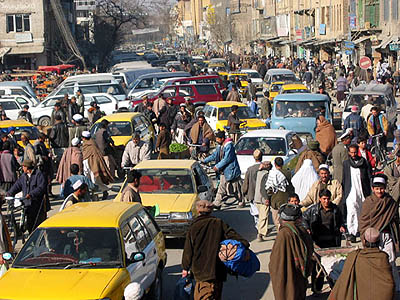
Official name of the country: Dowlat-e Islami-ye
Afghanestan (Islamic Republic of Afghanistan)
Area: 647,500 sq km
Population: 28,513,677 (July 2004 estimated), with
an estimated total of 2 million refugees in Pakistan and 800,000 in Iran.
In the latest Census of 1978 the population was said to be 15,54 millions.
Ethnic groups: Pashtuns 42 p.c, Tajiks 27 p.c, Hazaras
9 p.c, Uzbeks 9 p.c, Aimak 4 p.c, Turkmen 3 p.c, Baloch 2 p.c, others
4 p.c.
Languages: Pashtu – used by the pashtun majority
– 35 p.c; Dari (the Afghan dialect of Persian) 50 p.c; Turkic languages
(primarily Uzbek and Turkmen) 11 p.c; plus 30 minor languages (primarily
Balochi and Pashai) 4 p.c. Bilingualism is very common. Pashtu and Dari
are official languages.
Religions: Sunni Muslims 85 p.c, Shia Muslims 15
p.c; Other religions (Zoroastrians, Jews, Christians, Baha'is, Hindus,
Sikhs) 1 p.c.
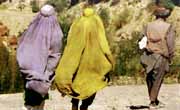 Capital:
Kabul
Capital:
Kabul
Other main cities: Kandahar, Herat, Mazar-e Sharif,
Jalalabad
Administration: The country is divided into 32 provinces
(Badakhshan, Badghis, Baghlan, Balkh, Bamian, Farah, Faryab, Ghazni, Ghowr,
Helmand, Herat, Jowzjan, Kabol, Kandahar, Kapisa, Konar, Kondoz, Laghman,
Lowgar, Nangarhar, Nimruz, Oruzgan, Paktia, Paktika, Parvan, Samangan,
Sar-e Pol, Takhar, Vardak, Zabol, Nurestan, and Khowst)
Life Expectancy: 46 years
GDP per capita: US $5.8 billion (IMF January 2006)
Growth rate: The
Afghan economy grew by an average of 25% (excluding drugs) between 2002-04.
Growth slowed to around 8% in 2004-05, due largely to the negative impact
of adverse weather conditions on agricultural production.
Currency: 1 Afghani = 100 puls
Major industries: Textiles, fruit and nuts, soap,
furniture, shoes, fertiliser, hand woven carpets, cement, natural gas,
coal and copper.
Major trading partners: Exports to Pakistan, the EU, India,
Russia and the United Arab Emirates; imports from Pakistan, Japan, Kenya,
South Korea, India and Turkmenistan.
National
anthem: The Taliban givernment prohibited music, and had therefore
no national anthem. The anthem of 1978, composed by Ustad Salim Sarmad,
with lyrics by Suleiman Laeq, was reintroduced in 2001, but already in
2002 it was replaced with a Mujahedin battle song, So
Che Da Mezaka Asman Wee.
The Loya Jirga in January 2004 decided upon the new constitution stating
that the National Anthem of Afghanistan shall be in Pashtu language, and
mention ”Allahu Akbar” and the names of the ethnic groups
of Afghanistan.
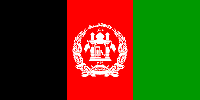 National flag: The flag which was Afghanistan´s
official during the period 1933–1973 was reintroduced as national
flag in January, 2002.
National flag: The flag which was Afghanistan´s
official during the period 1933–1973 was reintroduced as national
flag in January, 2002.
Independence: Afghanistan was united as a nation
state by Ahmad Shah Abdali, who ruled the country 1747–1772. He established
a hereditary royal dynasty. During the 19th century and the beginning
of 20th century Afghanistan fought three wars against Great Britain, who
never succeeded in colonizing the country.
Afghanistan was granted full independence through the Treaty of Rawalpindi
of 8 August 1919.
 Current
history: The king Zahir Shah, who had ruled the country since
1933 was thrown out of power in 1973 in a coup led by his cousin Mohammed
Daoud. He proclaimed himself the first president of Afghanistan. Daoud
himself was overthrown in April 1978, in the so called Saur revolution,
led by the marxist party PDPA. Afghanistan was turned into a Soviet style
peoples´s republic. Factional infighting in the ruling party (between
the Khalk and the Parcham factions) led eventually to a
disastrous invasion by the Soviet Union in December 1979. A civil war
started to rage the country, with mujahedin fighters all over the country
battling the government army and more than 100 000 Soviet soldiers.
Current
history: The king Zahir Shah, who had ruled the country since
1933 was thrown out of power in 1973 in a coup led by his cousin Mohammed
Daoud. He proclaimed himself the first president of Afghanistan. Daoud
himself was overthrown in April 1978, in the so called Saur revolution,
led by the marxist party PDPA. Afghanistan was turned into a Soviet style
peoples´s republic. Factional infighting in the ruling party (between
the Khalk and the Parcham factions) led eventually to a
disastrous invasion by the Soviet Union in December 1979. A civil war
started to rage the country, with mujahedin fighters all over the country
battling the government army and more than 100 000 Soviet soldiers.
Soviet Union withdrew its troops in 1989, but the war against the Soviet-backed
government continued till 1992 when the mujahedin forces finally succeeded
in defeating the last communist president Najibullah. A loose coalition
of Islamic mujahedin groups took over power, but because of sharp internal
divisions between the different leading personalities new fighting broke
out and a new war over control of the country. Local warlords took power
over the regions, and Kabul was totally destroyed during the new civil
war.
The Taliban, an islamic student´s movement among pashtun refugees
and based at madrasas in Pakistan, was created during this time, with
support from the Pakistani intelligence agency ISI. Their new militia
conquered Kandahar in the south, which was to become their central base,
in 1994, and then continue taking over more and more of the country. Kabul
fell to the Taliban in 1996.
 The
Taliban government led by the one-eyed Mullah Muhammed Omar changed
the status of the country into the Islamic Emirate of Afghanistan, and
Mullah Omar was proclaimed to be the Amir-al-Mumineen, i e the
Caliph of our time. The flag was changed into the muslim banner shown
here beside.
The
Taliban government led by the one-eyed Mullah Muhammed Omar changed
the status of the country into the Islamic Emirate of Afghanistan, and
Mullah Omar was proclaimed to be the Amir-al-Mumineen, i e the
Caliph of our time. The flag was changed into the muslim banner shown
here beside.
In spite of its rapid takeover of the country the regime never became
internationally recognized, except by Pakistan, Saudi Arabia and the United
Arab Emirates. The seat in the United Nations was kept by the ethnic tajik
dominated old mujahedin government led by Burhanuddin Rabbani,
whose control of territory inside Afghanistan continued to diminish up
till the beginning of 2001, when the Shura-e Nezar (or so called
Northern Alliance) only controlled the mountainous northeastern province
of Badakshan and the Panjshir valley north of Kabul. The Alliance´s
commander, former Defence Minister, Ahmad Shah Massoud, was furthermore
assasinated by Taliban agents in the beginning of September 2001.
Things then changed abruptly and extremely hasty. The reason was the terrorist
attack in U.S.A on 11 September. Because the Taliban refused to hand over
the Al-Quaida leader Osama bin Ladin, staying in Afghanistan, in
spite of evidence given by the U.S. that he was the man who planned the
terrorist attacks, the U.S and Great Britain declared a War on Terror,
which resulted in starting a bomb war on Afghanistan on 7 October, 2001.
Read articles in Swedish and International media
on this war and its effects on South Asia.
The bomb war paved the way for the Northern Alliance to
reconquer the parts of Afghanistan it had vacated during the last years,
and on 13 November Kabul was liberated from the Taliban. Shortly thereafter
also the southern part of the country fell, as the Taliban government
broke down. A peace conference was held under the auspices of the United
Nations, in Bonn, Germany, in the beginning of December 2001. Representatives
from the Northern Alliance and opposition groups based outside Afghanistan
decided to form an interim government with broad representation of all
ethnic, political and religious groups except the Taliban.
This was followed up the Loya Jirga, a grand conference in Kabul
in the beginning of June 2002. 1 500 elected representatives from all
parts of the country came together to form an interim government, and
decide upon Afghanistan’s definite political structure for the future.
This including drawing up a new Consitution and arranging general elections
in the country.
Following the US-led coalition war that led to the defeat of the Taliban in November 2001 and the formulation of the Afghan Interim Authority (AIA) resulting from the December 2001 Bonn Agreement, International efforts to rebuild Afghanistan were addressed at the Tokyo Donors Conference for Afghan Reconstruction in January 2002, when 4.5 billion US-dollars was collected for a trust fund to be administered by the World Bank. Priority areas for reconstruction include the construction of education, health, and sanitation facilities, enhancement of administrative capacity, the development of the agricultural sector, and the rebuilding of road, energy, and telecommunication links.
The Afghan Constitutional Commission posted its
draft constitution in Pashtu and Dari languages on 3 November 2003.
The draft constitution envisages a strong presidency, elected directly
by the people through fair and transparent means and reaffirms the nation's
links with the Islamic faith. The draft constitution providing a strong
presidential system of government was approved by 502 delegates at another
Loya Jirga (Grand Assembly) held in Kabul during the period 14 December
2003 – 4 January
2004. A decision was taken to hold presidential elections in the Summer
2004. The Afghan Transitional Administration Chairman Hamid Karzai then
signed the recently approved Afghan Constitution into law on 26 January,
promising a democratic Islamic state under a strong presidency, a bicameral
parliament, and an independent judiciary.
Both parliamentary and presidential elections were initially meant to
be held in June 2004. Due to the constant bad security situation in
the country the elctions were however postponed. Now presidential elections
took place on 9 October 2004, whereas the parliamentary elections were
postponed till 18 September 2005.
In April 2007, Afghanistan was admitted as a full fledged member of the
South Asian Association for Regional Cooperation, SAARC. More
information.
Parliament: The shape of Afghanistan's
new and democratic government was set out in the constitution approved
in January 2004 by Afghan elders and local dignitaries. The constitution
established Afghanistan as an Islamic republic where men and women have
equal rights and duties before the law. The government consists of a powerful
presidency with two vice presidents, a bicameral legislature and an independent
judiciary.
The Upper House is called Meshrano Jirga
(The House of Elders), and consists of an unspecified number of local
dignitaries and experts appointed by the 34 provincial councils, the district
councils, and the president. This house forms more of an advisory role
rather than a maker of law. Still, the house has some veto power.
The Lower House of the Afghanistan parliament is called Wolesi
Jirga (House of the People), has 249 seats ans is elected for a
period of five years. At least 64 delegates (two from each province) must
be women; they are appointed by the president who also nominates two representatives
of the physically disabled, and two Kuchi nomads. Wolesi Jirga will have
the primary responsibility for making and ratifying laws and approving
the actions of the president.
Elections to the Lower House of Parliament (Wolesi Jirga)
and to the Provincial Councils were held in Afghanistan on 18 September
2005. These were the first such elections for 36 years. The Afghan Independent Election Commission intends to hold the next Wolesi Jirga election on September 18, 2010. More information
on Wolesi Jirga.
In April 2007, a number of former mujahedeen leaders, members of the
former communist regime and a figure from country's royal family, most
of whom fought each other during country's decades-long war, formed a
new political party, the Jabhey Mili or National
Front. It is headed by the former president of the mujahedeen government
Burhanuddin Rabbani and some members of Karzai's current cabinet, including
Vice-President Ahmad Zia Massoud. The new group also includes the country's
former warlords, Mohammad Qasim Fahim and Abdul
Rashid Dostum, the former defence minister Ismail
Khan, and Mustafa Zahir, the grandson
of Zahir Shah, Afghanistan's last king (who passed away on July,
23, 2007). The Jabhey Milli favours a parliamentary system and have called
for direct elections for 34 provincial governors, in its manifesto.
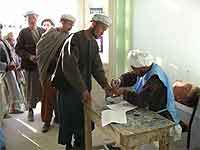 •
Guide to Parliamentary Elections in Afghanistan. Report by Andrew
Reynolds, Lucy Jones and Andrew
Wilder, on the eve of the parliamentary elections in September
2005. A one-stop source of information on the Wolesi Jirga and
Provincial Council elections that includes an explanation of the
elections process, the different actors involved, and the key
issues that will affect electoral procedures. Report by Afghanistan
Research and Evaluation Unit, AREU, August 2005. •
Guide to Parliamentary Elections in Afghanistan. Report by Andrew
Reynolds, Lucy Jones and Andrew
Wilder, on the eve of the parliamentary elections in September
2005. A one-stop source of information on the Wolesi Jirga and
Provincial Council elections that includes an explanation of the
elections process, the different actors involved, and the key
issues that will affect electoral procedures. Report by Afghanistan
Research and Evaluation Unit, AREU, August 2005. |
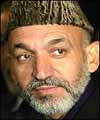 President:
The Pashtun leader Hamid Karzai was elected to the post by
the Loya Jirga on 13 June, 2002. (photo to the left). After winning
the presidential elections in October 2004 he was installed as the first-ever
elected president of Afghanistan on 7 December 2004.
President:
The Pashtun leader Hamid Karzai was elected to the post by
the Loya Jirga on 13 June, 2002. (photo to the left). After winning
the presidential elections in October 2004 he was installed as the first-ever
elected president of Afghanistan on 7 December 2004.
A second presidential election in Afghanistan was held on August 20, 2009, and again won by Hamid Karzai. He will be inaugurated for a second five-year term on 19 November 2009. ![]()
The main contenders for the presidential elections, besides the incumbent president, were Dr Abdullah Abdullah, former Minister of Foreign Affairs; and Dr Ashraf Ghani, former Minister of Finance. Massive fraud marred the August 20 presidential election, highlighting the scale of corruption in Afghanistan's government.
On the same day, 20 August 2009, provincial councils were elected.
The Taliban had called for a boycott of the elections, describing it as a ”program of the crusaders”.
Other leading politicians:
• Burhanuddin Rabbani (Jamiat-i-Islami party). Tajik.
President in the mujahedin government which had to flee the capital Kabul
in 1996. Afterwards he continued to be the formal head of state, and he
returned as president to Kabul in November 2001. But he resigned from
the post in favour of Hamid Karzai after the UN conference in Bonn.
• General Mohammed Fahim, tajik, Ahmad Shah Massouds successor.
One
of the country’s two vice presidents.
• General Rashid Dostum, uzbek, warlord and leader for the
Jombesh-e Melli Islami party. Deputy Defence minister.
• Ismail Khan, tajik, Jamiat-i-Islami, warlord and Governor
for Herat.
• Abdul Karim Khalili, hazara, leader for the Shia party Hezb-e-Wahdat,
one of the country’s two vice presidents.
• Ahmed Zia Massoud, brother of killed war hero
Ahmed Shah Massoud.
• Abdul Rassoul Sayyaf, pashtun, leader for Ittehad-i Islami.
| More information on Afghanistan |
• Wikipedia, the free encyclopedia, Afghanistan
The Human Development Report 2009 data on Afghanistan
• Office of the President/Islamic Republic of Afghanistan. Provides information on Afghanistan's National Budget, the Government's Donor Assistance Database, and on major international conferences on Afghan reconstruction.
• Institute for Afghan Studies (IAS), Internet-based institute run by some of the World’s leading scholars on Afghanistan, with the goal ”to foster a better understanding of Afghan affairs through scholarly research and studies.” The IAS homepage provides valuable information about the political situation in Afghanistan (including accords and treaties), the role of the Taliban in Afghan history, about the UN Talks on Afghanistan in Bonn, etc. It offers bibliographies for Afghanistan and the Taleban, a who-is-who of the Taliban, background information about the history of Afghanistan and its economy, maps and much more.
Academic Info: Afghanistan Studies. Directory of Online Resources for the Study of Afghanistan
Afghanistan WWW Virtual Library History, created by the University of Kansas, USA, in 1993
BBC News Country Profile Afghanistan
Afghanistan Research Group (ARG) – an informal association of scholars, writers, diplomats and of aid and development experts who have worked or still work in or on Afghanistan – offers a web site full of information, articles and links to Internet Resources on Afghanistan. The site is managed by Dr Bernt Glatzer, Berlin.
Afghanpedia is a new resource service of Sabawoon Online, providing quality information on Afghanistan for research papers, articles, general references, and more.
EurAsianet.org offers a wealth of updated information on the country. A service funded by the Soros foundation.
The Library of Congress, USA, offers through its Country Studies Web site detailed Information on all Aspects of Countries round the Globe. Look for Afghanistan. Information contained in the Country Studies On-Line is not copyrighted and thus is available for free and unrestricted use by researchers. As a courtesy, however, appropriate credit should be given to the series. Unfortunately, though, the information on Afghanistan is not updated since 1997.
World Bank Group/Afghanistan: Constantly updated data reports, publications, statistics, projects etc, for Afghanistan
CIA –The World Factbook: Afghanistan
The British Foreign & Commonwealth Office (FCO) advice on safety aspects on travelling to Afghanistan
The Swedish Government’s Division for Democratic Issues, based at the Ministry of Justice, regularly publishes yearly reports about the human rights situation in countries all over the World. Read the 2007 Report on the Human Rights Situation in Afghanistan (in Swedish only).
SASNET - Swedish South Asian Studies Network/Lund
University
Address: Scheelevägen 15 D, SE-223 70 Lund, Sweden
Phone: +46 46 222 73 40
Webmaster: Lars Eklund
Last updated
2010-09-09
